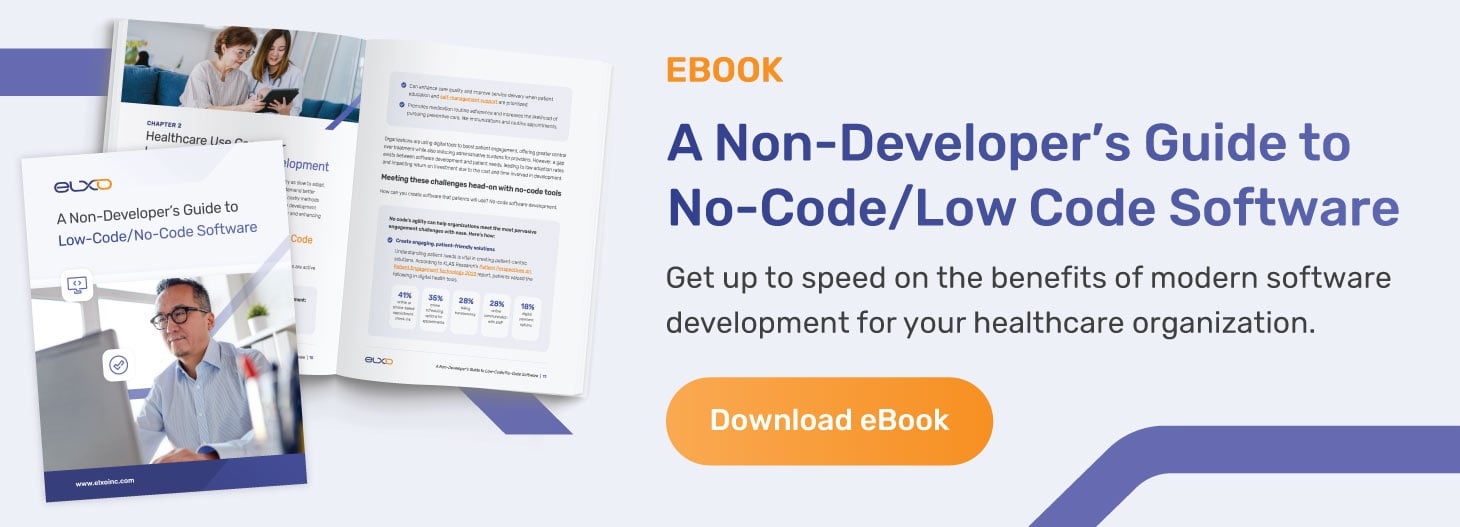In the traditional model of healthcare app development, collaboration can prove difficult. Non-technical team leaders may have trouble conveying what they need to engineers, and those disconnects only prolong already-lengthy development cycles, which can strain working relationships.
In today’s fast-paced healthcare landscape, there’s a critical need to rapidly evolve technology that meets customer demands and doesn’t drain the organization’s budget. It’s time to vary up conventional software development methods to better support cross-functional collaboration among staff while delivering both more effective and more agile solutions. And that’s where no code/low code comes in.
No code/low code: A collaborative approach to development
According to Gartner research, the low-code development technology market has grown by about 20% year over year since 2021, with the market projected to grow by another 25% in 2024. Gartner also estimates that, by 2025, 70% of new applications developed by organizations will use no-code or low-code platforms.
What’s driving this shift? One of the major factors is time-to-market. With a no-code/low-code approach, organizations can avoid building an application from scratch. All components are pre-configured, enabling you to simply drag and drop a feature you want into the core app. This can accelerate the development process and make it more flexible if you need to change components, adjust workflows, or build out features to make them more robust.
One of the other major factors is collaboration. Whether you’re outsourcing development, working with an internal team of developers, or relying on a scrappy IT team, building a new app requires all parties to work together seamlessly. However, there are often misalignments between what end users (e.g., clinicians and patients) need and what is technically feasible for developers to build.
In a no-code/low-code model, anyone can be a “business developer” — someone who isn’t technically savvy but knows the issues facing the team. Business developers can see the various parts of the application laid out visually, making it easier to identify what end users require and how the solution can meet their needs. Then, it’s just a matter of dragging and dropping the feature into the workflow.
This seamless development process breaks down the barriers facing collaboration — there’s no longer a technical language barrier, and all parties can better provide input. The end result is often a more effective, more widely adopted, and more affordable solution.
How no-code/low-code platforms support stronger working relationships
It’s clear no code/low code can be a smoother, more modern approach to healthcare app development, but how, specifically, can it support stronger working relationships? Here are a few ways these platforms can encourage better partnerships across the organization:
They empower business developers
Business developers know the struggles staff and patients are facing better than anyone, but the gap between that knowledge and how to solve the issues technically can be difficult to bridge. Instead of spending time going back and forth with these individuals about potential solutions, the IT staff can better showcase what features are available in a no-code application and how they can help end users.
On the low-code side, your business developers may say, for example, that they like the pre-configured analytics module, but they’d like an even more robust dashboard. To address this, the technical engineers could easily add code in the backend that pulls data from even more sources to broaden the insights delivered, providing a bigger picture that will further empower users in making data-driven decisions.
They allow faster, smarter, and more effective collaboration
With no-code/low-code technology, collaboration is much smoother thanks to intuitive visual interfaces, drag-and-drop functionality, and interactive workflows that make it easy to adjust on the fly. The plug-and-play nature of this approach enables anyone, regardless of technical expertise, to visually map out workflows and actively participate in building out the core user experience.
The flexibility of these solutions also enables feedback to be implemented in real time. If a feature isn’t seeing much use, it can be removed from the workflow or moved elsewhere with a few clicks. Users can then test the experience immediately, allowing for faster optimization.
They enable teams to launch apps faster
With less time spent on coding and building an entire app from the ground up, your organization can get the solutions it needs faster than ever. This is critical in healthcare, as new technologies are constantly evolving and patients expect a base level of digital service.
No-code/low-code platforms can help your team design and deploy effective digital experiences without unnecessary delays caused by internal confusion or unreachable expectations. The flexibility to adjust the workflow also helps ensure that users are getting what they need as soon as possible, whether it’s additional features or more robust functionality.
They reduce shadow IT
According to TechTarget, shadow IT is when employees are forced to comply with frustratingly complex and tedious IT policies or use tools they don’t understand or like. This frustration leads to them bypassing procedures or using unauthorized devices and software that suit their needs better.
For IT, especially within healthcare, this can be dangerous, because ignoring established policies and using unauthorized technology can increase the risk of exposing sensitive patient data to bad actors. It may also lead to compliance issues, resulting in fines and even litigation.
No-code/low-code healthcare app development allows all stakeholders to provide input into the final product. This can help drive wider adoption, decrease the burden of compliance, and consolidate workflows, avoiding a scenario in which users are forced to use unfamiliar, disparate tooling. When everyone is on the same platform and working within the bounds of what’s approved, collaboration is easier, and the IT team can relax a bit.
They support needs broadly and narrowly
When developing new software, it can be easy to lose sight of the organization’s biggest priorities due to lengthy development timelines — whether those priorities are to decrease the administrative burden on staff or deliver high-quality patient experiences at scale.
With the low barrier to entry for no-code/low-code development, you can bring more — and more diverse — stakeholders into the design process. This will help ensure that each team can get what they need from the app while balancing organizational goals. Patients, clinicians, and IT staff will receive support from a solution that’s equal parts intuitive and effective.
Partner with a vendor you trust
All this said, the key to effective collaboration is trust. Your internal team members need to trust one another to align priorities and move organizational goals forward together. This applies externally, too — when vetting a vendor, make sure they hear your feedback and understand what you need. This will instill trust between your team and the vendor’s team, providing the foundation for a fruitful partnership.
Modern healthcare app development doesn’t have to mean pitting non-technical health leaders against tech-savvy engineers. With no-code/low-code technology at your fingertips and a consultant team you can trust, your organization can foster collaboration between all parties and build solutions that fit everyone’s needs.
Looking for a partner you can trust? Reach out today, and our experts at Elxo will help you identify and build customized solutions for your organization’s top challenges.







